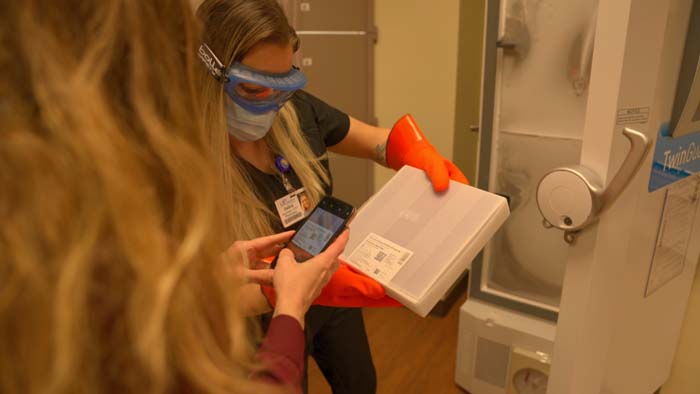COVID-19 claims 12th life in Union County
Published 4:00 am Saturday, December 19, 2020

- Staff at St. Charles Medical Center in Bend place doses of the Pfizer-BioNTech COVID-19 vaccine in ultra-cold storage on Thursday, Dec. 17, 2020.
UNION COUNTY — It was a week of extremes in Oregon in the fight against COVID-19.
Trending
The Oregon Health Authority reported the state broke the 100,000-case threshold Friday, Dec. 18, at 12:01 a.m., and COVID-19 claimed more than a hundred lives in the state in a two-day span, including two Union County residents. The disease’s death toll in the county now stands at 12.
Gov. Kate Brown on Thursday, Dec. 17, extended her declaration of a state of emergency regarding COVID-19 for an additional 60 days, until March 3, 2021. The previous executive order was set to expire Jan. 2. The declaration, acceding to the press release from the governor’s office, is the legal underpinning for the Brown’s COVID-19 executive orders and the Oregon Health Authority’s health and safety guidance.
“As we near 100,000 cases of COVID-19 in Oregon, and with hospitals and health care workers stretched to their limits, there is no doubt that COVID-19 continues to pose a public health threat,” Brown said in the press release. “We continue to lose too many Oregonians to this deadly disease, including over 100 reported deaths in the last two days.”
Trending
And the first doses of a COVID-19 vaccine — Pfizer and BioNTech first-of-its kind messenger RNA vaccine — arrived at hospitals in Ontario and Portland this week, and the first of Oregonian health care workers received protection from a disease that has claimed more than 300,000 American lives.
“These are the darkest days of this pandemic,” Brown continued in the release. “And yet, hope has arrived. Beginning this week, each time another Oregonian is vaccinated against COVID-19, we are one step closer to the day when we can return to normal life. In the meantime, we must keep up our guard.”
Gains and losses
COVID-19 spread continued in Union County. Between Sunday, Dec. 13, and Friday, Dec. 18, the Center for Human Development, the county’s public health arm, reported 35 positive cases.
“Cases really can fluctuate, so it’s possible that you could have another large number of cases come through over the next few days that could bump the number up again, but right now it seems like we kind of increased for a while and went down,” said Carrie Brogoitti, CHD’s public health administrator. “So far, it looks like we could be going down, which is good news.”
With 56 cases the week before, case counts remain high enough to keep Union County under Oregon’s “extreme risk” public health measures. The county must record fewer than 60 cases in a two-week period to drop into the “high risk” category, which would allow for indoor activities, including dining.
Cases of COVID-19 tapered off across Oregon this week as well. The number of weekly reported infections dropped 11% compared to last week — the first week-over-week decrease in eight weeks. Nonetheless, statewide daily cases continue to number in the thousands every day, and weekly deaths continue to number in the hundreds.
The Oregon Health Authority reported the deaths of two more Union County residents this week. The first was a 73-year-old man who tested positive on Dec. 3 and died Sunday, Dec. 13, at Grande Ronde Hospital, La Grande. The second was a 75-year-old woman who tested positive on Nov. 27 and died Dec. 10 at St. Luke’s Medical Center in Boise.
“The hard part is that we, unfortunately, have also seen an increase in the number of deaths over the past few weeks,” Brogoitti said. “I think it’s good that we have had a lower number of cases, but what we find is that when we have one of those spikes, usually a couple of weeks later is when we’ll see deaths happen, if they’re going to happen.”
The statewide COVID-19 death toll climbed to 1,304 as of Friday.
COVID-19 outbreaks continued to grow in La Grande. The Oregon Health Authority’s weekly report listed one new case at Wildflower Lodge, which is the site of 70 cases and five deaths. Northwood Manufacturing’s outbreak ticked upward, growing from 16 to 18 cases.
Union Elementary School also made OHA’s weekly report, where two cases of infection in staff or volunteers were reported. District Superintendent Carter Wells said between 40 and 50 students were quarantined due to cohort exposure, and Union schools began their winter break on Friday, Dec. 18.
The Center for Human Development is holding another free COVID-19 testing clinic Monday, Dec. 21 from 11 a.m. to 4 p.m. at its office, 2301 Cove Ave., La Grande. To register and schedule a test, go to doineedacovid19test.com.
Schools fight to stay open
The county’s smaller schools — Union, Imbler, Elgin, Cove and North Powder — expect to be able continue offering in-person instruction to their K-12 students thanks to new guidance from the Oregon Department of Education on Wednesday, Dec. 16.
La Grande School District Superintendent George Mendoza announced in a livestreamed town hall the same day that when La Grande students return from Winter break on Jan. 11, 2021, kindergarten and elementary students will return for in-person instruction.
“That’s something I hope that we’re all happy about,” a smiling Mendoza said. “I’m definitely very excited about the future for our school district.”
La Grande schools grades K-5 will attend school daily from 8 a.m. to 1 p.m., while sixth grade students will be in two cohorts that will attend school in-person from 9 a.m. to 1:30 p.m.
Middle and high school students could be allowed to return to in-person instruction on Jan. 27.
A slight pinch
The race to vaccinate the United States against COVID-19 began in earnest this week, with health care workers across the nation, including some in Ontario, Bend and Portland receiving the first doses. Union County, however, has to wait on future vaccines before local immunization can begin.
The next COVID-19 vaccine in the pipe for an FDA emergency use authorization is the Moderna vaccine. The Oregon Health Authority told reporters in a media briefing last week that rural counties with fewer health care workers should expect their first doses of a COVID-19 vaccine to be the Moderna vaccine, not the Pfizer-BioNTech vaccine that was rolled out in Portland and Ontario.
Similar to the Pfizer vaccine, the Moderna version is a messenger RNA vaccine that boasts a 94% efficacy rating.
Brogoitti said Union County is waiting on details from the state and is working on a plan for local distribution.
“Unfortunately, I am still learning about what vaccine distribution is going to look like,” Brogoitti said. “We’re still fairly early in the process, still gathering information from the Oregon Health Authority.”
Grande Ronde Hospital spokesperson Mardi Ford said the hospital is working to put vaccination plans in place and had put together a vaccine planning task force, though the hospital lacked confirmation about what vaccine it would receive first, how many doses it could expect or when those doses might arrive.
The Moderna vaccine
The Food and Drug Administration fast-tracked the Moderna vaccine for a decision on emergency use earlier this week after it conducted an analysis of Moderna’s ongoing clinical trial. FDA briefing documents shed light on how it works.
The vaccine is administered in two injections 28 days apart. Two weeks after the second injection, the Moderna vaccine was effective in preventing symptoms of COVID-19. The vaccine worked regardless of age, ethnicity or the presence of preexisting conditions, such as obesity and diabetes.
The vaccine does have common side effects. Most people reported pain at the injection site, while roughly two-thirds of people reported fatigue or headache. Other common symptoms include muscle and joint pain and chills.
Two key advantages of the Moderna vaccine come in how it is distributed and stored. Unlike its cousin from Pfizer, the Moderna vaccine can be stored between minus 5 and minus 13 degrees Fahrenheit — balmy compared to Pfizer’s minus 76 to minus 112.
The vaccine also is distributed in smaller batches.
That combination of factors, OHA have said, make the Moderna vaccine more practical for use in rural areas.
As of press time Friday, Dec. 19, the FDA had not yet ruled on an authorization for use of the Moderna vaccine in the U.S.









